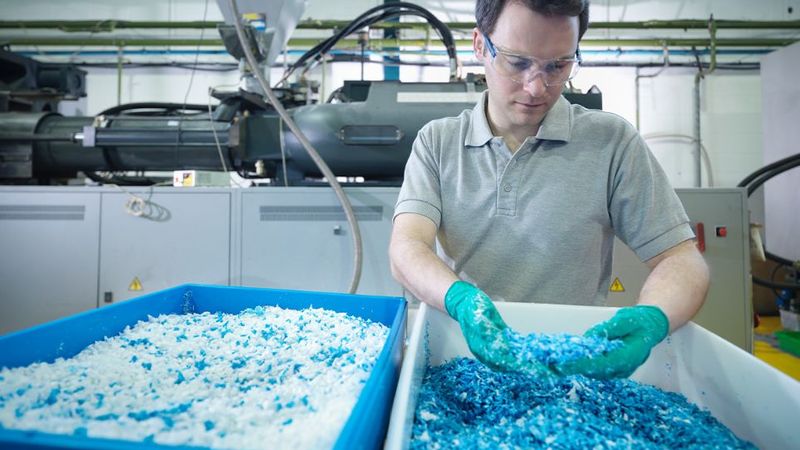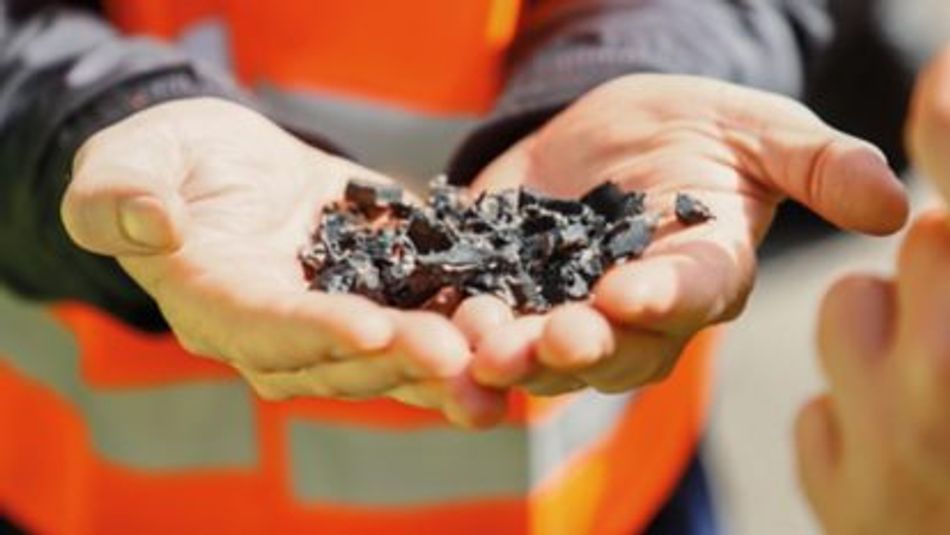The circular economy for low carbon footprint plastics
A closed-loop system for engineering quality plastics provides dividends to products, economy and people.

Image credit: POM
Faced with the pressing problem of climate change coupled with the impact of finite resources, the circular economy (CE) is a potential solution to many of the environmental, business and production issues in the world today.
A CE is a business model of production and consumption which veers away from the traditional linear method of making something - consuming it - and throwing it away. Instead, it harnesses practices which are all about keeping materials in the economy, be it by repairing, reusing, sharing or recycling products to extend their lifespan.
A CE can encompass many differing types of industries and resources, but all are based on the same principles[1]. Firstly, the desire to eliminate pollution and waste. The second is to protect and regenerate nature, and the third is to enable the circulation of products and materials at their highest value while reducing waste.
Global and national policies are evolving to enable the implementation of the CE, helping to make it one of the tools of tackling climate change. This was illustrated in 2020[2], when the European Commission announced its European Green Deal. The European Green Deal includes the new Circular Economy Action Plan which features proposals on more sustainable product design, reducing waste, and empowering consumers - such as with the right to repair[3].
An environmental benefit and a business model
A CE has many benefits, with the primary positive impact on the environment.
By using waste as a feedstock for the production of new materials, fewer materials have to be consumed to produce new products, meaning energy use and extraction of raw materials are reduced and fewer products end up in incineration plants or landfill at the end of their life.
Another, sometimes overlooked benefit, is to operational effectiveness and financial resilience. Companies which have established a CE model are able to reduce their dependence on raw material suppliers, especially during a time when supply chains are under increasing pressure[4].
It also helps answer the problem of fossil resources being finite. Using waste as a resource will help mitigate against resource scarcity in the future.
While a CE can be adopted for many different materials, it has huge potential for the plastics sector and its resulting impact on the environment. In this article, we will look at how the plastics industry is being impacted by the growth of the CE.
The global impact of plastics
Plastics are a vital product used for many different applications and their use has only been accelerated by the pandemic, with personal protective equipment (PPE) such as facemasks being produced in huge quantities. But this has also led to more waste, with an estimated 129 billion face masks and 65 billion plastic gloves needing to be disposed of each month[5].
The wider impact of plastic on the world’s oceans has also gained worldwide attention in recent years, and for good reason. Of the 300 million tons of plastic produced every year[6], at least 14 million tonnes end up in the ocean every year, with plastic making up 80% of all debris in oceans and waterways. This waste can harm sea creatures and also find its way into the human food chain.
But there is also the underlying effect of plastic production on the environment too. Most plastics are made from fossil raw materials and are produced in plants which use fossil fuels to power them[7]. Fossil fuel used for transport further contributes to the industry’s carbon footprint. A report[8] released by the environment group Beyond Plastics suggests that the production of plastics will release more greenhouse gas emissions than coal plants in the US by 2030. While not strictly part of the CE, the chemical industry is already working on solutions for this. Companies are shifting their energy supply more and more towards renewable energy and are using bio-based and recycled feedstocks for the production of plastics.
Plastics and the circular economy
It is generally accepted that a CE for plastics should be built around the following principles:
- Plastic can be reused, recycled, or composted in practice.
- The use of plastic is fully decoupled from the consumption of finite resources.
- Plastic is free of hazardous chemicals, and the health, safety, and rights of all people involved are respected.
Practical techniques
But with those guiding principles in mind, what does that actually look like in practice?
There are a few methods already being used which contribute to a CE for plastics and they centre around recycling and reuse.
Reusable consumer products is one method that has gained popularity in recent years. From coffee shops to grocery bags, plastic products are no longer being thrown away after one single use but being reused on each occasion. Not only is this beneficial for the environment, it reduces production costs and raw material use for the company and increases brand loyalty.
Recycling is another vital pillar of a CE for plastics - and one that can be extended to engineering-grade plastics that cannot be simply resued in the same manner as consumer plastic products.
Plastic recycling falls into four main categories.
- Mechanical recycling is used for the physical recycling of plastics like polyethylene terephthalate (PET) and high-density polyethylene, which are typically used to make soft drinks bottles or containers. The process uses grinding, washing, sorting and reprocessing to repurpose plastic material for use as new products.
- Chemical recycling is a process by which the material is broken down to its original chemical building blocks, so that they can be built back up again into new products.
- Dissolution recycling is a recycling process where one polymer type in mixed plastics waste is dissolved in a solvent so it can be separated from the other polymer types and recovered with high purity.
- Organic recycling uses the controlled microbiological treatment of biodegradable plastics waste under aerobic conditions (composting) or anaerobic conditions (biogasification).
While the technology to enable the recycling and reusability of plastics exists and is effective, there are other factors that need to be introduced to really make CE as productive as it can possibly be: mainly product design and the introduction of recycling/reuse infrastructure.
Product design is a big factor in producing items that can be reused and recycled. Along with the ‘right to repair’ introduced by the European Union, it’s essential that more products are designed with things like reusability and recycling in mind.
It is also important for there to be a clear plan and system for the life cycle of plastics to be in place to enable recycling to happen, where used plastic is collected from consumers and sent to recycling facilities so the plastic can then be kept inside the economy.
Designing the systems for parts and products to be returned to recycling facilities is core to achieving the CE. The loop of the systems should drive design decisions of the part, rather than being an add-on or bonus.

Changing mindset
But there also needs to be a change in mindset both for companies and consumers. For decades, consumers have been used to the idea of using something and throwing it away, this has had a negative impact on the environment, but has also meant companies had an equally wasteful mindset. They were creating new, disposable products from scratch rather than using recycled materials. This not only had an impact on the environment but could prove more costly for firms too.
As well as developing the infrastructure and technology to build an effective plastics CE, education has to be a factor, with consumers and wider society realising the benefits of a plastics CE, but companies also understanding the clear business case for it too.
For companies, this means they have to re-evaluate how they think about their product lifecycle. Developing and implementing the technology – such as recycling technology – is not enough, they have to think more about the products they develop, their reusability, how easy or difficult they are to repair, and what happens to them at their end of life.
A long-term view is also vital because initial investment is needed to implement recycling systems and technologies. But with the increasing importance of the green agenda across all aspects of society, investment now will produce dividends in the future.
The Circular Economy Challenge
Wevolver, in partnership with Growth Garage, the business accelerator from Mitsubishi Chemical Advanced Materials, Mitsubishi Chemical Europe, and Mitsubishi Chemical Methacrylates, invites engineers, designers, entrepreneurs, startups, companies, and students to submit their ideas, technologies, and products as part of the 2022 Circular Economy Challenge.
The challenge is looking for innovators throughout the plastics circular economy who want to make use of advanced low carbon footprint engineering plastics or have developed innovative recycling technologies for advanced engineering plastics.
The winners of the challenge are invited to participate in a pilot program with Growth Garage, the business accelerator from Mitsubishi Chemical Advanced Materials to further develop their idea. The total value of this program is $25,000.
The challenge is looking for participants in two key areas:
1. Recycling Technology
2. Products & Parts
For more information and how to submit to the challenge, head to the challenge page.
About the sponsors:
The Circular Economy Challenge is sponsored by Mitsubishi Chemical’s group companies Mitsubishi Chemical Advanced Materials, Mitsubishi Chemical Europe, and Mitsubishi Chemical Methacrylates.
Growth Garage is a business accelerator program from Mitsubishi Chemical Advanced Materials that supports and helps to grow new ideas to tackle some of today's biggest engineering challenges.
Mitsubishi Chemical Corporation
Mitsubishi Chemical Corporation, headquartered in Tokyo, Japan, has the global organization and infrastructure to leverage local and global synergies through the vast network of affiliated companies. With over 40,000 employees at 351 affiliates in more than 30 different countries, Mitsubishi Chemical provides a comprehensive range of solutions based on chemistry that contribute to solve social and environmental issues. Our vision is to realize the sustainable well-being of people, society, and our planet Earth – we call it KAITEKI.
Mitsubishi Chemical Europe
Mitsubishi Chemical Europe is a wholly-owned subsidiary of Mitsubishi Chemical Corporation. The company, with headquarters in Düsseldorf, offers and sells highly developed chemical-based products. The portfolio includes performance polymers, carbon fiber & composites, polyester films, aluminum, and metal composite sheets as well as semiconductor solutions for a wide range of industries. In an additional role as regional headquarters for Europe, located in Frankfurt, it promotes the exchange between group companies in Europe and management in Japan. The stem of all activities is to contribute to the KAITEKI corporate philosophy, which strives for sustainability for people, society, and the earth.

